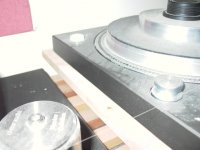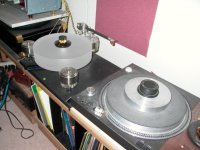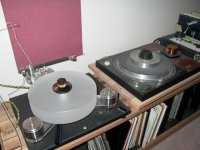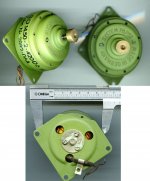Jacques Merde: "VHS tape is not compliant and therefore not particularly forgiving in this respect. Better drive with a good source."
I agree. If driving the passive platter with an idler turntable, then the active platter is not used as a motor. It become a high speed motor driving an idler-wheel driving a platter and tape-driving another platter. Too many interfaces. Drive it with a direct drive turntable, a good source, so the DD table can act like a big motor and pulley. Keep it simple.
Again, the downside is that the set-up will take up a lot of space.
Last edited:
I have gotten the new bearings installed and it runs smoothly now. I think this motor has other issues though.
It gets too hot to touch!
I ran it all day a couple of days and it runs fine it just gets really hot.
I have tried both 3uF caps I had with the same results.
Does this indicate a problem in the windings?
The specs you posted earlier indicated that this motor has a rise of 40 C over ambient which means this is a fairly hot running motor.. Taking 20 C as typical then when fully warm this motor is running at 60 C or 140 F which is uncomfortably hot to the touch.
I had an early Hitachi cassette recorder with a two phase hysteresis-synchronous motor and it actually had a small fan on the rear shaft to cool the motor which even so ran noticeably warm..
If it holds speed under load and doesn't smoke it probably is fine. You can perhaps lower the voltage slightly once it starts which should reduce both heat and to some extent vibration. (Which since it is a hysteresis-synchronous motor should not be very pronounced to start with.)
Last edited:
In my case, I use Technics SL110 first model in this kind of product got a most powerful motor, I did modification of it's speed control, separated all the electric part away and changed speed adjuster to a better quality parts, extendsion wires to the motor coil a bit of work 15 wires, after the mods, it stable like a rock. but the platter not a really 90 degree sharp, I use elastic thread as the belt ( elastic material sound really wonderful vs non elastic things with lively), so I cut a really small grove to hold the thread ( no need send to machine shop for cutting just hold a sharp bite firm and hand turn can cut ) weight balance between two platters also will change the sound quality, you can adjust to your own favor.
In this picture, I put a Technics SL-1400Mk2
.
cheers tony ma
Attachments
makaiyumtony: "Technics SL110 got a most powerful motor. I did modification of its speed control, separated all the electric part away and changed speed adjuster to a better quality parts. Extension wires to the motor coil a bit of work, 15 wires. After the mods, it's stable like a rock, but the platter not really 90 degree sharp, I use elastic thread as the belt so I cut a really small groove to hold the thread. weight balance between two platters also will change the sound quality, you can adjust to your own flavor"
Nice job, Tony! Thanks for sharing. It's great to see like minded people here. You're right about the early SL1100 that has a similar motor like the SP10, very high torque. I used to have three SP10Mk2 tables and was going to experiment with one, to take the platter and motor out of its stock chassis and mount it on a separate plinth and run extension wires to the electronics. I sold all the SP10's befor the project never was completed. I would love to hear the result of that. Oh well,... In the future I might try another similar project as I have an acrylic platter as the passive platter and I can use some of my DD table collection to drive it.
Nice idea on modding the sloped platter by cutting a groove for thread drive. I haven't tried thread or elastic belt yet but I am quite happy with tape and tape is easy to find and easy to splice to desired length, whereas a belt needs to be custom made and a thread is hard to be tied to a smooth knot.
Fun project! Any more future projects, please post and share. Thanks!
.
directdriver; Nice idea on modding the sloped platter by cutting a groove for thread drive. I haven't tried thread or elastic belt yet but I am quite happy with tape and tape is easy to find and easy to splice to desired length said:Elastic thread use as the belt,idea from the designer of SPJ, she sent a roll to my friend who own a SPJ TT charged $20, because so thin the knot will not bother, length fit also easy because of stretch just move and adjust the tension at the same time, tension also effect to the sound quality, I found similar thread only $4 a roll even better result from local garment material supply, 1 to 1 ratio drive, the thread can last quite long so far still in the first set, but my friend's ac motor is different story, the reason of sound quality change I guess is it can work as a spring to naturalize small speed change in turning. I don't think we can measure out that little change's difference in turning speed but can detect by the sound quality difference, once you try will never go back again. it needs hand turn both first before switch power on and adjust weight balance for almost stop completely at the same time after switch off
happy new year
tony ma
I purchased two green flywheel papst motors from ebay for possible use in a diy turntable project. I know nothing of them and got little info from the seller but the price was right...highest bidder at 16.50 cdn...I am looking to get a power supply/speed control for them...I will try to attach pics for these (original from ebay)...Motor numbers are as follows: KLO 14.50-2-420D followed by a triangle symbol...second line reads as follows: 7cha Nr 7882-064...what type of motor is this AC or DC?..could these possibly be 3 phase?...no indicaton of voltage, frequency etc...any info or help would be appreciated.
Attachments
Last edited:
Back in the seventies I worked as a mechanical designer for Scully Recording instruments in Connecticut. I worked on tape transport design and the preferred Hystersis Synchronous Motors at the time were from Ashland, Bodine, ELINCO ( Electric Indicator Company ) Papst and Beau Motor. They generally had sleeve bearings nearest the capstan for low noise and ball bearings at the far end. I still have a 2-speed ( 600 RPM & 1200 RPM ) Papst motor and a 300 RPM Beau Motor from those days. I bet they would make excellent motors to drive turn tables. Both are so-called
"inside out motors" I'm going to check out the companies I've mentioned
to see if they're still around. I know Papst is. This thread reminded me of
the fact that I still have those motors and it gave me the idea to possibly
design and build my own turn table. That is when I'm done with building
my own tangential tone arm. I'll report if I find out anything about the
companies I've mentioned.
Thanks,
Ralf
I purchased two green flywheel papst motors from ebay for possible use in a diy turntable project. I know nothing of them and got little info from the seller but the price was right...highest bidder at 16.50 cdn...I am looking to get a power supply/speed control for them...I will try to attach pics for these (original from ebay)...Motor numbers are as follows: KLO 14.50-2-420D followed by a triangle symbol...second line reads as follows: 7cha Nr 7882-064...what type of motor is this AC or DC?..could these possibly be 3 phase?...no indicaton of voltage, frequency etc...any info or help would be appreciated.
3 wire, looks like an AC, 2 phase synchronous. Fire them up with 2x 20v AC with one phase running through 0.22uf of capacitor and see if they turn. Older motors are very unlikely to be low voltage, especially when as heavily built as they are. Looks like they have two matched and one odd colour wire, one would assume the matched pair are the input for each phase and the other the return.
two phase?
...in Canada we have either single phase or three phase...I am an Electrician but only know some things about electronics...two phase as you say would mean ac voltage applied from two circuits 90 degrees out of phase with one wire for return...house service is nearly always 240v three wire circuit (two hots one neutral)...one hot to neutral is 120v witch is a regular plug in a house...to get 20v two phase sounds a bit tricky from that...maybe a special transformer I have not yet seen??...Any suggestions? I'll also mention the three wires coming from these motors are all different colors...was also wondering if there is a simple test to identify motor type with a ohm meter?
3 wire, looks like an AC, 2 phase synchronous. Fire them up with 2x 20v AC with one phase running through 0.22uf of capacitor and see if they turn. Older motors are very unlikely to be low voltage, especially when as heavily built as they are. Looks like they have two matched and one odd colour wire, one would assume the matched pair are the input for each phase and the other the return.
...in Canada we have either single phase or three phase...I am an Electrician but only know some things about electronics...two phase as you say would mean ac voltage applied from two circuits 90 degrees out of phase with one wire for return...house service is nearly always 240v three wire circuit (two hots one neutral)...one hot to neutral is 120v witch is a regular plug in a house...to get 20v two phase sounds a bit tricky from that...maybe a special transformer I have not yet seen??...Any suggestions? I'll also mention the three wires coming from these motors are all different colors...was also wondering if there is a simple test to identify motor type with a ohm meter?
Last edited:
Stuart, it's the same in the UK, single phase and 3-phase. Referring to the motor as two phase just means the two inputs are separated by 90 degrees by adding a small capacitor to one of the inputs.
Just find a 20v transformer, split the output into two wires and pass one of them through a capacitor of 0.22uf. (.22uf is just a nominal value you might find you need anything upto a couple of uf to get the correct lag)
You can't really identify the motor with a multi-meter, measurement of winding resistance doesn't tell you much. You could of course connect the outputs to your multimeter and spin the drive shaft quickly to see what comes out AC/DC?
Just find a 20v transformer, split the output into two wires and pass one of them through a capacitor of 0.22uf. (.22uf is just a nominal value you might find you need anything upto a couple of uf to get the correct lag)
You can't really identify the motor with a multi-meter, measurement of winding resistance doesn't tell you much. You could of course connect the outputs to your multimeter and spin the drive shaft quickly to see what comes out AC/DC?
Has anyone considered steam power?
NAS use underpower (volt ?) AC motor that need a hand spin to start....
Stuart, if you hold the spinning motor in your hand you will easily be able to feel the difference between different lag amounts between the two phases. I can feel the difference between 0.22 and 0.2uf on my LP12 motor quite easily.
Let's find out what voltage your motor needs first, then we can talk power supplies. Different versions are better for different requirements, you also need to consider the tolerance/drag of your turntable bearing and platter load.
If you motor need under 60v then I can wholeheartedly recommend this Roehren-und-Hoeren :: Thema anzeigen - Luxusnetzteil für Synchronmotoren mal anders It was no use for my needs, 120v but it genuinely is the most accurate and adjustable AC controller you can DIY.
Let's find out what voltage your motor needs first, then we can talk power supplies. Different versions are better for different requirements, you also need to consider the tolerance/drag of your turntable bearing and platter load.
If you motor need under 60v then I can wholeheartedly recommend this Roehren-und-Hoeren :: Thema anzeigen - Luxusnetzteil für Synchronmotoren mal anders It was no use for my needs, 120v but it genuinely is the most accurate and adjustable AC controller you can DIY.
Has anyone considered steam power?
I could have sworn that link was going to be a RickRoll.crazy
NAS use underpower (volt ?) AC motor that need a hand spin to start....
Reminds me of a Monty Python skit: "Try the wow, flutter, bacon, egg and wow and flutter. That hasn't got much wow and flutter in it."
.
I just happened to have two identical ones but I have also used several turntables with speed adjustment such as the PL-570. Basically, any turntable with flat rim platter and speed adjustment will work. Models to recommend are Technics SL-M3, JVC QL-F6, Pioneer PL-570 & PL-550, etc... Or you can always add a plate on top of another turntable acting as a pulley, in this case the ubiquitous Technics SL-1200Mk2 will work great as a turntable "motor-pod." Get one at second hand price and it will beat most fancy motor-pods costing an arm and a leg. And it will make you pay attention to motor quality and realize all this attention to fancy shiny blig bling thick platters is misguided. Get the source of rotation, the motor, right and with quality, the sound will benefit. The two turntable approach saves me the trouble and money to find a high speed motor with proper speed control electronics - too much hassle for me. I am quite satisfied with the result.
In this picture, I put a Technics SL-1400Mk2 with a broken tonearm to goo use. I added flat rim platter, a salvaged part, on top of the Technics platter acting as a pulley. You can even add an idler wheel in between the two turntables. The passive platter is from an Empire 208 belt-drive turntable.
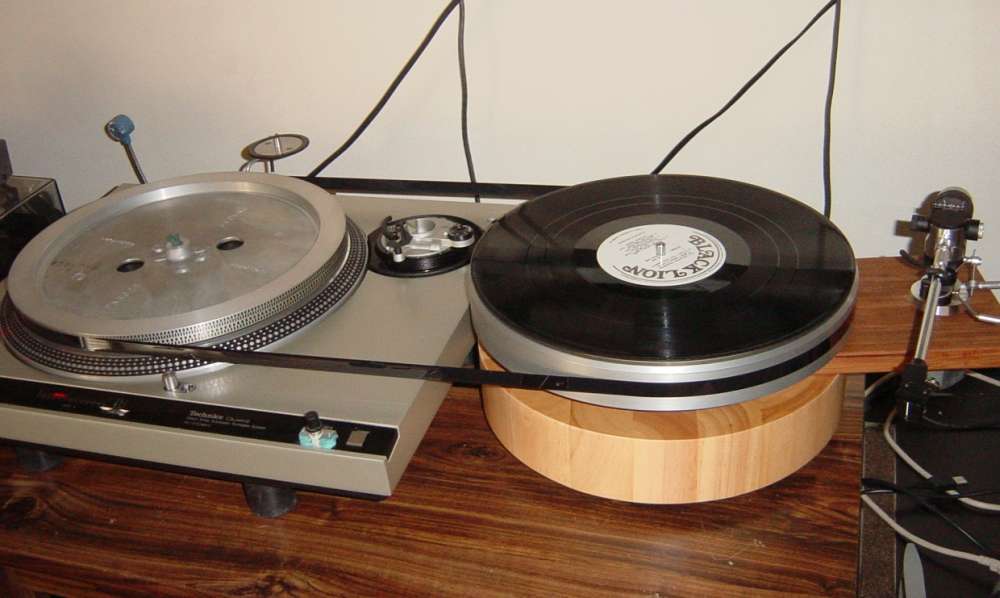
I have similar idea without belt...got two flywheel motors without removable pully just flat surface but got an idea to use with sub platter and rubber bushing around sub platter.. motors being 120 degrees apart from sub and main platter driven by sub platter direct...i will keep u posted and got a Philips sub and bearing for less than 30 bucks delivered...alot of work to do yet
.
Just read through this entire thread & I have a request. Can someone please post a simple diagram/schematic of an ac synchronous motor arrangement using an amp & sine wave? This is for someone quite willing to blow himself up in the search for speed stability  I think I understand most of how it works but want to make sure. Thanks all. Pretty new to this forum & love it.
I think I understand most of how it works but want to make sure. Thanks all. Pretty new to this forum & love it.
- Home
- Source & Line
- Analogue Source
- The Official Turntable Drive System/Motor Thread!
